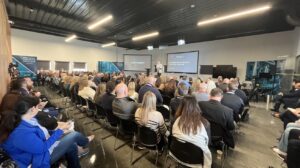After two full days of talks and panels from some of the most innovative minds out there, Time Machine 2018 has officially come to an end. If you missed anything, don’t worry—sign up here to receive monthly thought leadership emails and get the first announcements about Time Machine 2019.

In the meantime, though, here’s everything to need to know from day two of Time Machine.
String theorist and novelist Tasneem Zehra Husain started the day with the assertion, “Possible, to me, seems like a very elastic term.” There is so much in the universe we are still discovering, she explained, right down to the very nature of spacetime, that our definition of “possible” must always be evolving.
On her heels were three speakers giving more concrete examples of the newest innovations of the possible. Aric Zurek, Director of Aftermarket Products and Services for Flowserve, profiled the changes he’s seen in the oil and gas and power industries. These industries tend to move slower than the average due to safety concerns, he said, but new product adoption is still happening faster than ever.
Next, Jordan Hefferan, GE Aviation’s Director of Digital Services, shared his vision of using aircraft data to reach a point where there is no such thing as unplanned downtime. Then SparkCognition’s Principal Product Manager for DeepNLP, Jaidev Amrite, shed some light on how technologies like natural language processing are enabling this elimination of downtime.
There was also discussion of how AI fits into more unusual or artistic disciplines. Anna Chaney, Data Scientist at Watson Applied Research, demonstrated how AI is creating art—and discussed the accompanying concerns of ownership—before playing an original composition from Watson Beat for the audience. Todd Young, Founder and CEO of Ballogy, explained how watching his son struggle to measure progress in basketball inspired him to create an app that lets young athletes the world over have access to training and metrics. Then Richard Garriott de Cayeux, CEO and Co-Founder of Portalarium, sat down with SXSW Chief Programming Officer Hugh Forrest to explain why video games still have a long way to go in terms of AI, and why they could be the perfect test ground for AI research.
CEO and Co-Founder of Bloomfield Robotics Tim Mueller-Sim took the stage next, telling audiences how robotics could increase efficiency in agricultural land use and productivity, and help meet the needs of a growing human population. Once he’d made the audience good and hungry, it was time to adjourn for lunch.
Vishal Lall, Senior VP and CSO for HPE, kicked off the second half of the day with a session on edge computing, explaining that 75% of data will be generated at the edge by 2022, and that new infrastructure and software architecture need to be created to adapt to this reality. Senior VP and Chief Digital Officer of Apergy, Ali Raza, then showed attendees how Apergy is bringing new value to its customers with data analysis, failure prediction, and the “AI oilfield.”
The following talk moved onto a different topic entirely, as Kristopher Gasteratos, Founder and President of Cellular Agriculture Society, discussed the environmental problems associated with meat production, and how CAS is working to make artificially produced meat available to consumers by the mid-2020s.
The next theme of the day was cybersecurity. With Austin Business Journal Technology Reporter Mike Cronin moderating, Cody Pierce, Principal Product Manager of Rapid7, and Pedram Amini, CTO of InQuest, explained how to ensure white hats keep the advantage against cyber threats. Their points included intentional evolution, access to data, and deterrence strategies. Then Bryan Lares, Director of Product Management at SparkCognition, demonstrated how AI solutions like DeepArmor are meeting these needs.

Following these up was Boeing CIO Ted Colbert. He walked the audience through the future possibilities for the field of aviation, including AI-designed aircraft, sensor-driven insights across supply chains, and better maintenance to avoid flight delays.
The final topic of the day was AI policy on an international scale. Elsa Kania, Adjunct Fellow at the Center for a New American Society, posed the question of whether China is now leading in the race for AI. Looking at the metrics, she concluded that the U.S. may still have an advantage for now, but it won’t last without some major catching up. She was then joined on stage by SparkCognition Founder and CEO Amir Husain, Co-Founder of Global Space Ventures Laetitia Garriott de Cayeux, and moderator Kaveh Waddell, AI and Robotics Reporter for Axios. Together, they discussed what steps, the U.S. needs to take to maintain a lead in AI and scientific innovation.
SparkCognition CEO Amir Husain then closed out the conference, with a talk on the emerging possibilities of AI and the expectations we’ve placed on it. “There’s the initial discourse that AI will solve every problem, and then the reaction that it’s a fraud. The truth is somewhere in the middle,” he argued. AI will certainly solve many if not most problems, but it won’t be next year, or in Q1.
“Therefore,” he concluded, “the greatest discovery that man has ahead of himself is some patience.”
Thank you to everyone who attended or supported us, and we can’t wait to see you all next year!
















